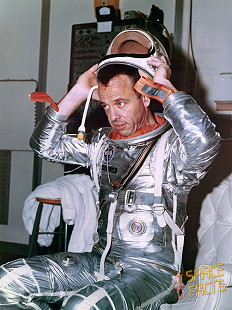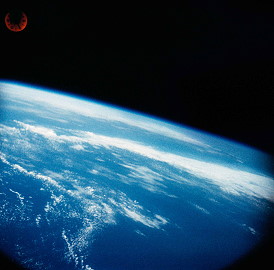The
Mercury-Redstone 3, MR-3 or Freedom 7 spaceflight was
the first human spaceflight by the USA and took place on May 05, 1961, with
Alan
Shepard as the astronaut. This first manned mission by the
USA, however, was only a 15-minute suborbital flight meaning above the limit of
space at an altitude of 100 km (54 nmi) and down again. The last part of the
mission name came from the Redstone rocket that was used for launching the
spacecraft. The Redstone rocket was not able to boost a
Mercury spacecraft into an Earth orbit.
The
countdown began at 00:30
UTC the previous night, with Alan
Shepard entering the spacecraft at 09:15
UTC, just over two hours before the planned 11:20
UTC launch time. At 07:05 a.m., the launch was held
for an hour to let cloud cover clear - good visibility would be essential for
photographs of the Earth - and fix a power supply unit; shortly after the count
restarted, another hold was called in order to reboot a computer at Goddard
Space Flight Center. The count was eventually resumed, after slightly over two
and a half hours of unplanned holds, and continued with no further
faults.
Alan
Shepard was subjected to a maximum acceleration of 6.3g just
before the Redstone engine shut down, two minutes and 22 seconds after launch.
He was now able to take manual control of the spacecraft, and began testing
whether he was able to adjust its orientation. The first thing he did was
position the spacecraft to it's retrofire attitude of 34 degrees pitch (nose of
spacecraft pitched down 34 degrees). He then tested manual control of yaw,
motion from left to right, and roll. When he took control of all three axes, he
found that the spacecraft response was about the same as that of the
Mercury simulator; however, he could not hear the jets
firing, as he could on the ground, due to the levels of background
noise.
Alan
Shepard resumed fly-by-wire control after retrofire,
reporting that it felt smooth and gave the sensation of being fully in command
of the craft, before letting the automatic systems briefly take over to
reorient the capsule for reentry. He then kept control until the g-forces
peaked at 11.6g during re-entry; he held the capsule until it had stabilized
and then relinquished control to the automated system. The descent was faster
than anticipated, but the parachutes deployed as planned.
After
splashdown a recovery helicopter arrived after a few minutes, and after a brief
problem with the spacecraft antenna, the capsule was lifted partly out of the
water in order to allow Alan
Shepard to leave by the main hatch. He squeezed out of the
door and into a sling hoist, and was pulled into the helicopter, which flew
both the astronaut and his spacecraft to a waiting aircraft carrier, the
USS Lake
Champlain. The whole recovery process had taken only eleven minutes, from
splashdown to arriving aboard.
In 1964 Alan
Shepard lost his flight status due to an inner-ear disease.
In 1969 it was surgically corrected and Alan
Shepard returned to flight status. In 1971 he became as
Commander of
Apollo
14 the fifth man walking on the Moon.
![]()



![]()















